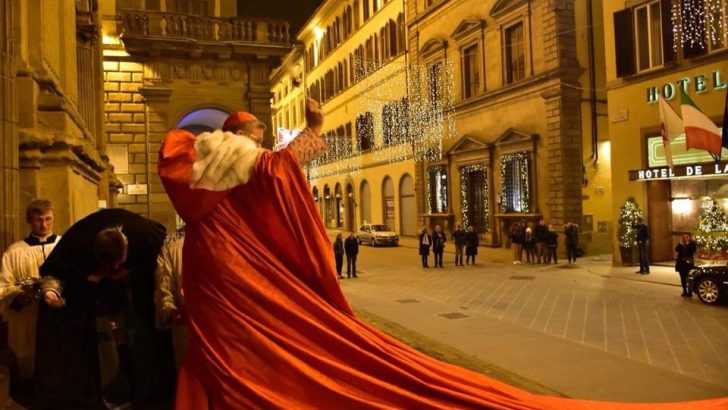Interpreting art – including religious art – can be a tricky and contentious business.
Take, for instance, a photograph posted by Crisis magazine columnist Austin Ruse of Cardinal Raymond Burke following Christmas Midnight Mass in Florence.
“A stunning photo!” proclaims lifesitenews.com author Diane Montagna from her @dianemontagna Twitter account, thanking @austinruse for posting it in the first place.
Papal biographer and Catholic Voices co-founder Austen Ivereigh was less impressed, responding from his @austeni account: “A perfect montage: Burke trailing a vast cappa magna in front of one of Florence’s most expensive hotels, while some flunky bows in an extravagant courtly pose. The challenge is to link this with the Incarnation.”
Montagna and Ivereigh both have a point: it is a stunning photo, and one that recalls the paintings of Caravaggio and other Italian artists of his time, but the challenge is how we can link such opulence to the story of how God became man and was born among us in a stable, dependent for warmth on straw and the surrounding animals.
The long, silk cappa magna – the ‘great cape’ – is intended to represent worldly finery, power and prestige, with the prelate wearing it being publicly stripped of the cloak before the altar, symbolically humbled before being dressed in his liturgical wear proper so as to enter the Church afresh as a ‘new man’. The point of the cloak, then, is that it is something to be removed, reminding us how worldly power and prestige have no place before God.
Wielded and read rightly, such symbolism can be powerful, but nowadays, as Ivereigh realises, such understanding is rare, and it may be that today the cappa magna has become a counterproductive anachronism, conjuring up suggestions of a Church keen to flaunt its wealth and prestige.
Symbols, unfortunately, are only useful insofar as people read them rightly, as jokes about the red shoes worn by Pope Benedict early in his papacy (and never made by Prada) showed – how often did those criticising them ponder how in the Church red is the colour associated with martyrdom, with the shoes recalling those in whose footsteps today’s Christians follow?
Scepticism about the Caravaggio-esque photo of Cardinal Burke is one thing, but criticism of the Nativity scene in St Peter’s Square has been another matter altogether, with the scene’s secondary theme getting unprecedented attention this year, but too often for all the wrong reasons.
The scenes around the crib depict the seven corporal works of mercy to which Christians are called, but too often, sadly, discussion focused on just one vignette – that depicting our duty to ‘clothe the naked’.
“An Asian child looks out at this year’s Vatican Nativity scene featuring a homoerotic figure,” wrote journalist @EdwardPentin. “The crèche, meant to portray the seven corporal acts of mercy, was made in Montevergine, a town famous for its close links with Italy’s LGBT community. The scene has outraged many Catholics.”
“To see this as homoerotic requires the kind of spectacles you can’t get at an optician’s,” responded @austeni, while South Africa’s Cardinal Wilfrid Napier felt obliged to weigh in from his @CardinalNapier account about how the whole display was solidly in the tradition of Italian art, wondering whether Michelangelo’s ‘Last Judgment’ scene in the Sistine Chapel, with its famously muscular male figures, might be similarly viewed.
The tragedy is that a wonderful opportunity is being squandered: the Nativity display was a spectacular demonstration of the Incarnation at the heart of a world in need of mercy; who would have thought this would have “outraged many Catholics”?


 Greg Daly
Greg Daly Cardinal Raymond Burke
Cardinal Raymond Burke 